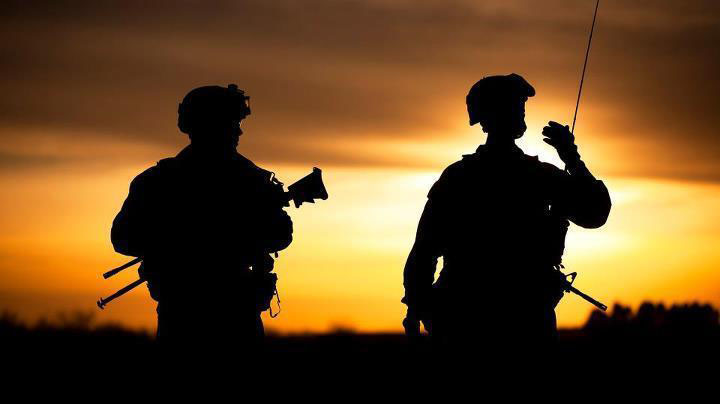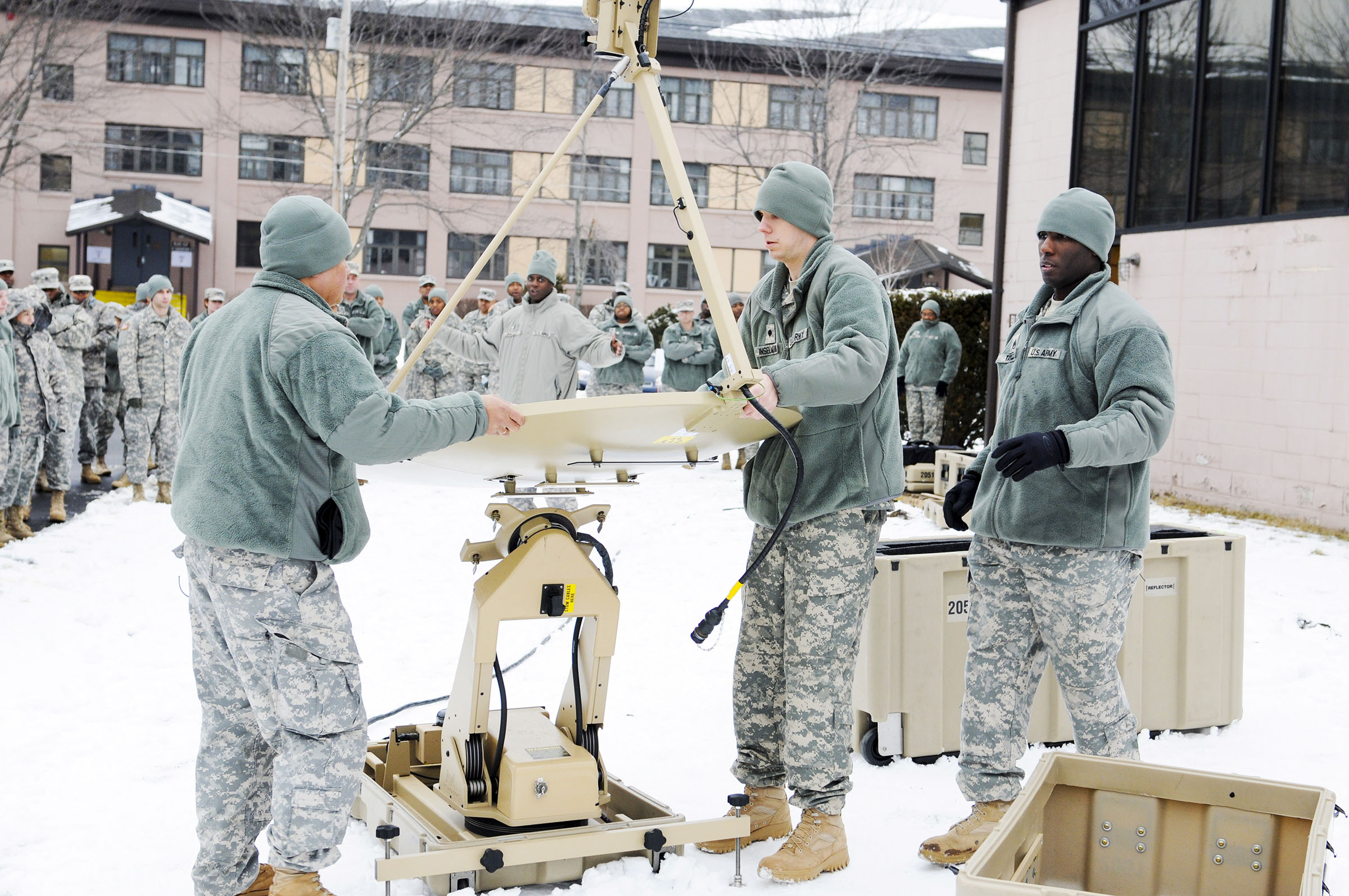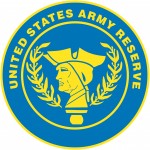
By Col. Marc Wilson
As the United States Army Reserve celebrates 107 years of service to the nation today, it’s also important to recognize that contributions made by Army reservists within the Army Acquisition Corps (AAC) in the last decade are apparent and significant, demonstrating tremendous success to the many technological advances made to support the longest war in our nation’s history.
For example in 2005, two United States Army Reservists, Lt. Col. Johnnie Edmonds and then Maj. Jeff Etienne were involved in new equipment training and fielding operations for the Combat Service Support Very Small Aperture Satellite and Combat Service Support Automated Information Systems Interface (CSS VSAT and CAISI). The fielding of CSS VSAT and the CAISI increased overall combat capability by enabling its CS and CSS personnel to electronically transmit and receive supply requisitions and near-real-time status reports on their orders and supply requisitions at any time and at nearly anyplace on the battlefield.
The strategic course that senior members of the Army Reserve, like Brig. Gen. Francisco A. Espaillat, (a member of the AAC) and Brig. Gen. Philip S. Jolly are pursuing is in support of the Total Army.

Brig. Gen. Fransisco Espaillat is the Commanding General of the 143rd Sustainment Command and United States Army Reserve Acquisition Proponent Advisor

Brig. Gen. Phillip Jolly, the Commanding General of the Army Reserve Sustainment Command, also commands the majority of Army Reserve Troop Programmed Unit formations serving in Army Acquisition Corps duty positions)
The Army Reserve is aligned with the active component’s strategy to drawdown and transition from combat operations in both Iraq and Afghanistan. The U.S. Army Reserve (USAR) is also repositioning itself to focus on the strategic challenges and opportunities that will define its future. The USAR provides about 65 percent of the Army’s total logistics capabilities, most of which is critical, dual-use equipment for enabling support to missions such as homeland security and defense support of civil authorities. Thus, it is vital that reservists in the AAC continue their presence in researching, developing and procuring new technologies that will better prepare our total Army force to address a world that is growing more volatile, more unpredictable and in some instances more threatening to the United States.
USAR laid the foundation for Army reservists to be a part of the AAC in the mid-1990s. The chief of the USAR at that time, then-Maj. Gen. Max Baratz also faced the difficult task of downsizing and reorganizing the USAR following the Cold War. Baratz assembled key leader representatives to assist him in that effort, including then-Maj. Gen. Thomas J. Plewes and Brig. Gen. James R. Helmly, future USAR chiefs. The strategic framework that Baratz identified to support the total Army reflected the factors that led then-Capt. Francisco Espaillat, a personnel proponent officer at the USAR Personnel Command, to establish future force structure within the AAC.
Plewes, the first appointed three-star chief of the USAR, continued to build on that strategic framework in the new millennium. He envisioned strengthening the strategic relevance of the USAR by supporting the AAC’s efforts to maintain the health of the U.S. defense industrial base. For the first time, reservists could be directly involved in the research, development and procurement of mission requirements for Army combat support and combat service support (CS and CSS). The USAR’s integration into the AAC over more than a decade has also reinforced Secretary of the Army John McHugh’s “Army Total Force Policy” through the Army’s equipping strategy, ensuring that the procurement and equipping processes enables the total force to perform the missions of the Army.

FORT DEVENS, Mass. — Staff Sgt. Atavis Taylor (right), casualty operations second shift officer-in-charge, 14th Human Resources Sustainment Center, assists two Soldiers from the 8th HRSC in assembling the Very Small Aperture Terminal System during Silver Scimitar 2012, the annual training exercise that prepares human resources Soldiers for overseas missions. (Photo by Spc. C. Terrell Turner, 214th Mobile Public Affairs Detachment)
Positively impacting the Army’s ability to achieve the mission from a program management (military occupational specialty (MOS) 51A) perspective is not the only role Army reservists play in supporting the total Army. Reservists within the AAC continue to build on a reputation of relevance and professionalism by serving in the contracting (51C MOS) role. Reservists who serve in acquisition roles make important contributions in developing weapon systems that serve all members of our total Army because of the changing role of the USAR in the overall structure of the force over more than a decade. With reservists fighting alongside active Army Soldiers, it has been more critical than in the past that the USAR have a role in the development of systems proportional to their use of those systems.
In recognition of the USAR and Army National Guard’s (ARNG) need for input into the development of training aids, devices, simulators and simulations (TADSS), a subordinate project office within the Program Executive Office for Simulation, Training and Instrumentation established an Assistant PM Reserve Component Training Systems office. USAR and ARNG personnel staffed that office and understood that the home station environment in which reserve component units train is significantly different from the environment found at the Army’s major posts. This understanding has resulted in flexible and mobile TADSS that can be distributed to armories and readiness centers across America.
The Army Reserve as an Army component provides a cost-effective way to mitigate risk to national security. In this period of dwindling resources and reductions in force structure and budget, reservists in the AAC remain strategic, operational, responsive and relevant. Nearly 300 reservists (both Active Guard Reserve and Drilling Reservists combined) serve in acquisition positions. Their success as acquisition professionals is a strategic focus that supports the Army’s CS and CSS mission set. To maintain our operational proficiency, it is vital to invest in the training and readiness of our Army Reserve force. The relevance of reservists in the AAC is evident by their presence and can only continue by maintaining a composite force structure that is educationally trained (in accordance with DAWAII certification standards), and given the opportunity to exercise their training proficiency.
The Assistant Secretary of the Army for Acquisition, Logistics and Technology, in conjunction with the USAR Acquisition Branch at Human Resources Command established centrally selected list (CSL) command and key billet positions within the Army’s acquisition program management and contracting force structure. The following table represents USAR CSL program managers and contracting commanders selected to serve in command and key program management billets.
| Name and Rank | CSL Acquisition Leadership Key Billet (Command) | Years |
|---|---|---|
| Lt. Col. Phil Lashivo | PM Petroleum and Water Systems (PM PAWS CSL) | 2000-2003 |
| Lt. Col. Francisco Espaillat | PM Petroleum and Water Systems (PM PAWS CSL) | 2003-2006 |
| Lt. Col. John (Steve) Meyers | PM Trailers (CSL) | 2003-2006 |
| Lt. Col. Dan Perrotta | Director of Contracting, ACC-NJ, Ft Dix | 2003-2006 |
| Col. Phil Lashivo | PM Tactical Radios (PM TR CSL) | 2006-2009 |
| Lt. Col. Mike Receniello | PM Petroleum and Water Systems (PM PAWS CSL) | 2006-2009 |
| Lt. Col. Richard Edler | Mission Installation Contracting Command, Fort Dix (CSL) | 2006-2008 |
| Lt. Col. Darrell Bennis | PM Combat Engineer and Material Handling Equipment (PM CE/MHE CSL) | 2007-2010 |
| Lt. Col. Jeff Carr | PM Sets Kits and Outfits (PM SKOT CSL) | 2007-2010 |
| Lt. Col. Brian Tachias | PM Sets Kits and Outfits (PM SKOT CSL) | 2007-2010 |
| Col. John (Steve) Myers | PM Joint Combat Support Systems (PM JLTV CSL) | 2007-2011 |
| Lt. Col. Francisco Espaillat | PM Combined Arms Tactical Trainers (PM CATT CSL) | 2008-2012 |
| Lt. Col. Kenneth Fields | Mission Installation Contracting Command, Fort Dix (CSL) | 2008-2010 |
| Lt. Col. Paul Phillabaum | PM Movement Tracking System (PM MTS CSL) | 2008-2011 |
| Lt. Col. Dan Perrotta | Director of Contracting, USAR Contracting Center, Ft Dix) | 2009-2012 |
| Lt. Col. Catherine Lassiter | Mission Installation Contracting Command, Fort Dix (CSL) | 2010-2012 |
| Lt. Col. Andrew Simpson | Joint Program Manager for Biological Detection Systems (JPM BDS CSL) | 2010-2013 |
| Lt. Col. Brian Tachias | PD Fixed Wing Aviation | 2011-2014 |
| Lt. Col. John Edmonds | MICC Ft Dix/WarFighter Support Center Commander (CSL) | 2012-2014 |
USAR Commanders and future CSL Key Leaders
| Name and Rank | CSL Acquisition Leadership Key Billet (Command) | Years |
|---|---|---|
| Mr. Scott Davis, Senior Executive Service and USAR colonel | Program Executive Officer Combat Support & Combat Service Support
|
Currently commanding |
| Brig. Gen. Francisco Espaillat | Commanding General 143rd Sustainment Command | Currently commanding |
| Brig. Gen. Phillip Jolly | Commanding General, Army Reserve Sustainment Command | Currently commanding |
| Brig. Gen. Jonathan McColumn | Commanding General, 103rd Sustainment Command | Currently commanding |
| Lt. Col. James Craig | Army Contracting Command-New Jersey | Currently commanding |
| Lt. Col. James Mote | 917th Contract Support Battalion | 2015-2017 |
| Lt. Col. Keith Harley | PM Acquisition Business Systems | 2015-2018 |
Senior USAR Acquisition Corps Leaders
| Name and Rank | CSL Acquisition Leadership Key Billet (Command) | Years |
|---|---|---|
| Brig. Gen. Francisco Espaillat | Army Reserve Proponent Advisor | Currently presiding |
| Brig. Gen. Phillip Jolly | Commands the majority of Army Reserve Troop Programmed Unit formations serving in Army Acquisition Corps duty positions | Currently commanding |
- Col. Marc S. Wilson currently serves as a Program Lead with PEO Soldier, Fort Belvoir, Virginia. He is Level III in Program Management and Contracting. He has been a member of the Acquisition Corps since 2003. He holds a Masters in Business Administration (Central Michigan University) and Strategic Studies Army War College). He has voluntarily deployed to Iraq (OIF) in 2005 and Afghanistan (OEF) in 2010.
Access AL&T is the premier online news source for the Army Acquisition Workforce.
![]() Click to Subscribe
Click to Subscribe








